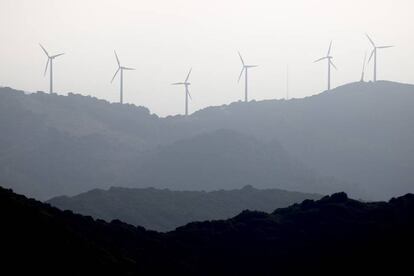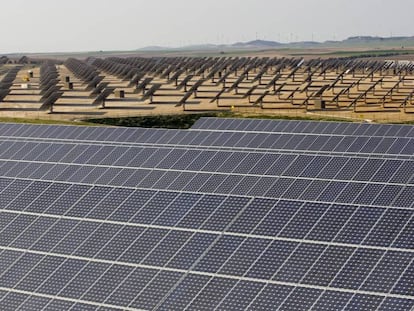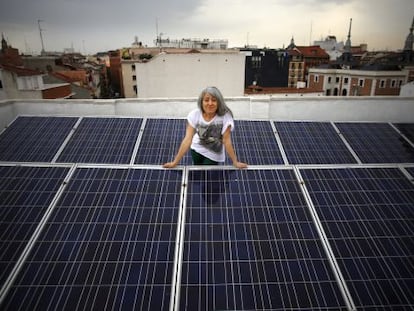Spain fails to hit annual renewable energy targets in 2015
Despite shortfall of 1.1%, Brussels is confident Madrid will meet its overall goal of 20% by 2020
Spain failed to meet the goals it had set for the use of clean energy in 2015. The country’s current national renewables plan establishes that 16.7% of total energy consumption would come from clean sources in 2015. But according to a report by the European Commission, the figure was 15.6%, more than a point short. But despite the difference, Brussels believes that Spain is on track to meeting its goal, and that by 2020, 20% of total energy consumption will come from renewables.

The year 2015 was an annus horribilis in the fight against climate change in Spain. Aside from seeing a more than 3% increase in greenhouse gas emissions, Spain failed to meet its own renewables goals, falling short of the government’s target by 1.1 percentage points. The two figures are related: by reducing the use of renewables to generate electricity, coal and gas use increased, sending emissions soaring.
European rules on implanting renewables, which set a common goal of 20% by 2020 for all 28 members, are based on two cornerstones. The first is a 2009 EU directive that sets countries’ individual goals; Spain’s is the same as the EU objective that 20% of all energy consumption should come from renewable sources by 2020.
Soaring electricity prices have sent inflation up 3% year-on-year in January
The other pillar consists of the plans that each state must present on the implantation of renewables. In the case of Spain, the current National Action Plan for Renewable Energies (PANER), is more ambitious than the EU’s own target, aiming for 20.8% by 2020.
Six other EU states also failed to meet their renewables goals in 2015, but overall, the European Commission says it believes that Europe will meet its 20% target by 2020.
“The European Commission compares countries’ data with the national trajectory included in the renewables directive. In the case of Spain, the trajectory for 2015/2016 is 13.8% and for Spain that figure is 15.6%,” say sources in Brussels, arguing that the Spanish government is on track to meet its 2020 goals. That said, the data for 2016 has not been released yet, so it is impossible to know what the average figure will be. In any event, the indications are that the use of renewables grew considerably in Spain last year.
While 2015 saw record use of coal to generate electricity, 2016 saw a 30% drop, thanks in large part to the use of hydro-electric power. Spain also imported more electricity than it generated for the first time since 2003.
By reducing the use of renewables to generate electricity, greenhouse gas emissions have risen
A spokesman for the Energy Ministry said Spain “is on track to meet the objectives of 2020, ahead of some other countries.” He also pointed out the ministry’s commitment to putting out to tender the generation of 3,000 megawatts of renewable energy.
Meanwhile, soaring electricity prices have sent the cost of living up in Spain, with a 3% year-on-year increase in inflation in January, according to figures released on Tuesday by the National Statistics Institute (INE), which it says have not been seen since the 3.5% of October 2012. Along with a rise in oil prices, the INE blames electricity price hikes for the increase, noting that more than 46% of households pay on the bases of prices set on the EU’s wholesale or spot price market.
The average price of a megawatt hour (MWh) on the wholesale market on January 1 was €51.9. On Tuesday, the last day of the month, the average price had risen to €73.27, a 43% increase. On January 25, the average price was €91.88, a 78.9% rise.
English version by Nick Lyne.
Tu suscripción se está usando en otro dispositivo
¿Quieres añadir otro usuario a tu suscripción?
Si continúas leyendo en este dispositivo, no se podrá leer en el otro.
FlechaTu suscripción se está usando en otro dispositivo y solo puedes acceder a EL PAÍS desde un dispositivo a la vez.
Si quieres compartir tu cuenta, cambia tu suscripción a la modalidad Premium, así podrás añadir otro usuario. Cada uno accederá con su propia cuenta de email, lo que os permitirá personalizar vuestra experiencia en EL PAÍS.
¿Tienes una suscripción de empresa? Accede aquí para contratar más cuentas.
En el caso de no saber quién está usando tu cuenta, te recomendamos cambiar tu contraseña aquí.
Si decides continuar compartiendo tu cuenta, este mensaje se mostrará en tu dispositivo y en el de la otra persona que está usando tu cuenta de forma indefinida, afectando a tu experiencia de lectura. Puedes consultar aquí los términos y condiciones de la suscripción digital.
More information
Archived In
Últimas noticias
The complicated life of Francesca Albanese: A rising figure in Italy but barred from every bank by Trump’s sanctions
Half of Scotland is in the hands of 420 property owners
Pinochet’s victims grapple with José Antonio Kast’s rise in Chile
Reinhard Genzel, Nobel laureate in physics: ‘One-minute videos will never give you the truth’
Most viewed
- Pablo Escobar’s hippos: A serious environmental problem, 40 years on
- Why we lost the habit of sleeping in two segments and how that changed our sense of time
- Charles Dubouloz, mountaineering star, retires at 36 with a farewell tour inspired by Walter Bonatti
- Reinhard Genzel, Nobel laureate in physics: ‘One-minute videos will never give you the truth’
- The Florida Keys tourist paradise is besieged by immigration agents: ‘We’ve never seen anything like this’










































